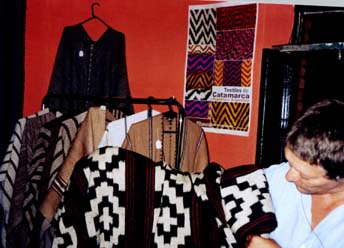World's finest clothes at the gates of the Inca's Puna
 Argentina's northern province of Catamarca holds an unexploited treasure. Vicuna's clothes are considered even better than Cashmere ones, but the lack of a sustainable industry deprives country’s poorest regions of extraordinary earnings.
Argentina's northern province of Catamarca holds an unexploited treasure. Vicuna's clothes are considered even better than Cashmere ones, but the lack of a sustainable industry deprives country’s poorest regions of extraordinary earnings.
The landscape in Argentina's northwestern region is wonderful. Unseen nature can be found in Southern Puna, the high plateau region that also comprises Bolivia and Peru. The Puna was once land of the Incas, the brave pre-Columbian Indian tribe that resisted European conquest for up to 160 years.
The Puna begins, in the South, in the province of Catamarca. There, it finds its highest tops, with small towns in a desert area, not less than 3.500 meters above the sea level. The region of Antofagasta de la Sierra in the north of the province holds 200 volcanoes, including the largest on earth: the Cerro Galan, with a 40 squared kilometer crater.
The 15.000 soul town of Belen is the southern gate of the Puna. It is located next to the Inca’s way, the grand pre-Columbian road that used to link Peru, in the North, to the western Argentine province of Mendoza, in the South. Belen is known as the cradle of Poncho, the typical gaucho cloak made of wool. The cheapest of them are made of sheep wool, as other ones are made of vicuna, world’s finest wool, and therefore, the most expensive.
The vicuna, a camelid that lives in the Puna can be woven into cloth as light and smooth as silk. In ancient Peru, the vicuna wool was reserved for the Inca and the royalty, exclusively.
Antonio Avar buys vicuna, llama –another camelid- and sheep wool to local villagers, in places impossible to reach with motor vehicles. “I bring the wool to Belen on horses and mules”, says Avar, a Buenos Aires born artisan who arrived in Catamarca four years ago and sells hand made clothes.
Avar employs around 60 local weavers, who patiently knit cloaks, coats, scarves and gloves to sell in Buenos Aires. Tourists can pay up to US$ 2.000 for a vicuna coat at the shops of Argentina’s capital.
“When I came here four years ago I could not recognize vicuna wool”, says Avar. “I used to sell rings and blankets as street vendor, until I encouraged myself and begun working on wool. Now my job took me to Europe, as ponchos became popular in London”.
Specialists say a good vicuna poncho can pass through the hole of a ring. Therefore, quality is essential to get a good reward from clients. Avar carefully selects the wool he would use to prepare the thread. He also selects weavers among local villagers to knit the clothes. But the process does not end here. As Incas did in their times, Avar tints the thread using only natural products as herbs, onions and nuts. “I boil the herbs in a receipt for a few hours and get the color I want”, he explains.
The Shinkal ruins
The trace of the Inca’s culture can be followed along the route number 40 from Belen. Taking that road travelers arrive at the historical village of Londres, the most antique second city of Argentina after Santiago del Estero, founded 400 years ago and named after British capital. It's a full walnut zone by excellence with two concentrations of population separated by a river. It holds 18th century churches and very much appreciated textile products, hatchery, tannery and pottery. But Londres was not always there. It had to be moved 16 times, as it was continuously seized by local Indian tribes with ties to the Incas.
Only 7 kilometers from Londres’ main square, is the most important administrative Inca settlement of the region: the Shinkal. The Incas developed the most revolutionized pre-Columbian culture in South America, until they were conquered by the Spanish in the XVI century. However, in what is now Argentina's territory, Indians resisted for almost 160 years the invasion of the Europeans.
To get the Shinkal, the natives walked seven or eight hours, bringing llamas as a beast of burden. As part of the Inca’s way, the Shinkal was a very complex big town, with ritual, ceremonial centers, squares, living houses and a special hall for the Emperor. A great part of this way was used in 1535 by the Spanish invader Diego de Almagro to arrive at the present Argentinean and Chilean north.
The Shinkal stands as a probe that, as no other region in Argentina, Catamarca holds a mixture of amazing landscapes and ancient traditions, almost unknown to the foreign visitor.
Hernan Etchaleco
Pravda.Ru
Picture: Antonio Avar holds a vicuna poncho at his sales shop in Belen, Catamarca.
Subscribe to Pravda.Ru Telegram channel, Facebook, RSS!


